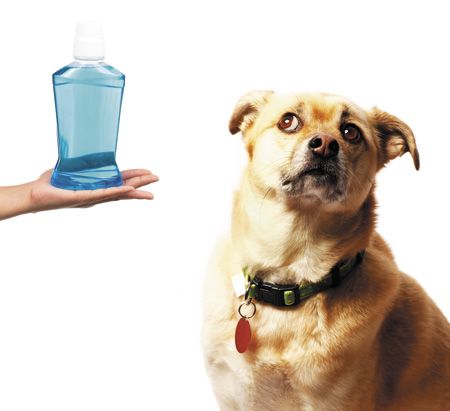Im treating my dogs hot spot with Listerine
Your response? Try these communication remedies for at-home dermatologic treatments gleaned from Dr. Google. The goal: Help the pet without shaming the client.

Don't make this face when clients tell you about their special home remedies. (Shutterstock.com)The desire for easy, low-cost, use-items-in-your-pantry-or-medicine-cabinet fixes to dermatologic problems often drives clients to the internet for information. What they often get, however, is misinformation. How are veterinarians supposed to address these strange and sometimes dangerous home remedies without embarrassing or shaming clients?
Encourage clients to have loose lips
First, give your clients an opportunity to tell you how they're really treating their pets at home. Try the following empathetic and non-accusatory conversation starters:
“I can tell this has been very difficult for you. It's terrible to see your pet suffer. Have you tried anything that provided any relief?”
“Does your pet take medications without a fuss? Do you have any trouble giving pills?”
“Have you ever tried bathing your pet or putting something on the area?”
“Have you tried anything that made the problem worse or better?”
Curb your criticism
It's important to note that the questions above will backfire if you fail to keep your facial expressions, tone and body language in check while listening and responding to their answers. Avoid appearing surprised, upset, incredulous or angry, which will teach your clients to keep their mouths closed. Remain passively interested, and don't interrupt or release heavy sighs of frustration.
If a client discloses the use of a home remedy, try the following approach:
Acknowledge that the client was trying to help. Depending on the client, you might even praise him or her for taking the initiative.
Ask questions about when the client started the treatment, how often it's being given and how it seems to be working. Doing so demonstrates that you aren't immediately dismissing the client's attempts to help the pet.
Avoid putting down the source of the treatment, be it the internet, a friend, a groomer or a breeder.
Explain why the overall concept was good (if it was) but why the home remedy was not the most effective option.
If a treatment is dangerous, focus your concern on the pet and explain that safer options are available. Educate without placing blame.
Go to the next page to see this guidance in action in four different cases ...

A dog you are treating for atopy that is generally well-controlled is presented for biting its paws. You check that the owner is giving the allergy medication you prescribed, and she reports that she's been cleaning the patient's paws with apple cider vinegar.
Sample response: “Good job stepping up your game! Topical therapy can be very helpful. When did you start the vinegar? How many times have you done it? Have you noticed any improvement? Does your dog mind the vinegar? When a previously well-controlled allergy patient starts chewing its paws, it usually means an infection has developed, but it could also just be an increase in allergy irritation. Vinegar can help some types of infections, but it can irritate sensitive skin as well. I need to examine your pet's paws so we can first determine if the problem is an infection or an allergy. If your pet cooperated for topical therapy, I will prescribe a product that will work better without irritating the skin.”

A client presents their atopic dog for a hot spot. Miraculously, he's been giving the medication you prescribed, but since discovering the hot spot, he's also been applying Listerine topically.
Sample response: “Topical therapy is really important for this type of lesion. What kind of Listerine are you using? Most formulations are antibacterial but not all of them. How does your dog respond to the Listerine? Do you think it's helped? This sore looks pretty bad. I'm going to check it to see what kind of infection is present and how severe it is. I think your dog will need oral medications in addition to topical treatment, but I don't recommend using Listerine long term because it can be irritating and may slow healing since it isn't designed to be used on dog skin.”

The client starts with, “My groomer told me … ”
Sample response: “A good groomer knows a lot about your pet and about taking care of your pet's hair and skin. It sounds like you have a caring and helpful groomer, which is great. Veterinarians have access to newer and more technical information. Your groomer isn't wrong, but we can do a lot more to help your dog.”

During the course of the physical exam, your client asks you about essential oils for pets. She uses essential oils on herself and has read that they can be used on dogs.
Sample response: “That is a great question. I have heard that essential oils really help some people, but we unfortunately don't have many high-quality veterinary studies about essential oils yet. The studies that have been published focus on essential oils as ingredients in other products. We may be able to include one of those in the treatment plan today. However, I would caution against applying an essential oil directly to the skin or giving it by mouth to your pet. Not all treatments that are safe for people are safe for pets, and because pets can't speak, it's difficult to determine when a treatment is causing irritation.”
Darin Dell, DVM, DACVD, works at Animal Dermatology Clinic in Indianapolis, Indiana, and enjoys woodworking and mountain biking.